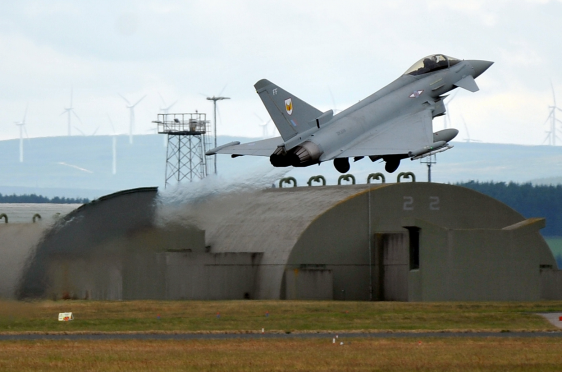A low flying RAF fighter pilot had to dodge a light aircraft over Loch Ness, an official probe has heard.
The Typhoon jet was flying at 360 feet above the ground and at 420 knots when the incident happened on July 19 over the Highlands.
The RAF pilot said that he entered a low-level system at 3pm and 20 miles south-west of Lossiemouth in Moray.
He called on the VHF common frequency and deconflicted his route with a Tucano turbo prop light aircraft that was entering low-level at a similar point.minutes later he again transmitted his position as ‘entering the Great Glen heading south-west.’
At the southern end of Loch Ness, he climbed briefly to maintain minimum separation distance against power lines and subsequently spotted a high-wing, light-aircraft approximately 3000 feet ahead, and 200-300 feet above.
He immediately took avoiding action by manoeuvring left and down to ensure separation – the closest point was estimated to be 1000 feet.
He assessed the risk of collision as ‘low’ but the light aircraft could not be traced.
A report by Air Command HQ to the UK Airprox Board – which investigates reported near misses – said the Typhoon pilot was conducting low-flying training in accordance with current regulations.
The Typhoon was not fitted with a collision warning system (CWS) however and since the light-aircraft could not be traced it is unknown whether or not it was equipped with a similar alert that could interact with the transponder on the Typhoon.
“Given the position and height of the Airprox, it is also unlikely that an air traffic service could have provided a barrier to this encounter,” said the report.
“The Typhoon pilot had transmitted his position and routing on the VHF common frequency approximately two minutes prior to the Airprox but had received no information from any other aircraft that his routing might have been in conflict with theirs.
“The final, effective, barrier in this case was ‘see and avoid’ – it cannot be determined if the light aircraft pilot saw the Typhoon but the Typhoon pilot saw the light aircraft at a range of approximately half-a-nautical mile and took action to increase separation, once again showing that disciplined lookout is essential…….”
In its conclusions the board said:”Unfortunately, this incident did not show on the National Air Traffic Services’ radar due to the height of the aircraft and so the light-aircraft pilot could not be traced.
“This meant that the board only had the Typhoon pilot’s report on which to base their assessment of the incident. Noting that the Typhoon pilot had called on the VHF common frequency, it was disappointing that the board could not determine whether the other pilot was also on this frequency or not, and whether terrain screening could account for him not hearing the Typhoon pilot’s call.
“Anecdotal evidence had shown that pilots operating in Scotland have welcomed the common frequency, but the RAF member noted that, in the main, there had been little feedback given to the RAF on whether the general aviation community found it useful or not, or to what extent it was used.
“The Typhoon was not fitted with a CWS, and so its pilot could not get any prior electronic warning of the other aircraft other than through the Typhoon’s on-board radar; given that the Typhoon was flying down the valley, the light-aircraft may have been obscured to the radar by the hills.
“Without a report from the light-aircraft pilot, the board could not determine whether the light aircraft might have been fitted with a CWS but it was considered unlikely.
“Ultimately, members agreed that see-and-avoid had worked in this incident in that the Typhoon pilot was able to see the light-aircraft with enough time to take avoiding action and ensure that there was safe separation between them.
“Both pilots were operating as they were entitled to, and so the board therefore concluded that the cause of the Airprox was simply a conflict in Class G (uncontrolled airspace), resolved by the Typhoon pilot. Members then debated the risk of the Airprox, with some members believing that safety had been degraded, whilst others argued that because of the early avoiding action by the Typhoon pilot normal safety standards had in fact pertained (Category E).
“In the end the Chairman put it to a vote and, by a large majority, the incident was assessed as Category E.”
